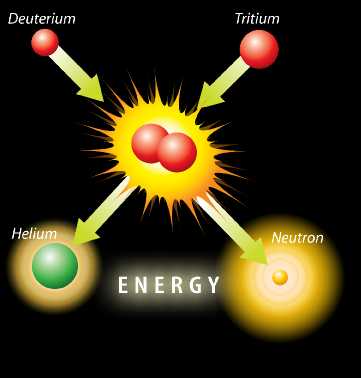 |
||||||||||||||||||||
 |
||||||||||||||||||||
 |
||||||||||||||||||||

![]()
Fusion energy is the energy produced when two light nuclei fuse together to form a heavier nucleus. This natural process takes place inside the Sun and all stars, and is the most abundant and widespread sustained manifestation of pure energy to be seen anywhere in nature.
 Fusion energy gave our planet its supply of fossil fuels, derived from early plant and animal life forms, all of which depended either directly or indirectly for their own energy supply upon the availability of sunlight, and stored it in their tissues, which were converted over time into the fossil fuels (coal, oil and gas) which we know today.
Fusion energy gave our planet its supply of fossil fuels, derived from early plant and animal life forms, all of which depended either directly or indirectly for their own energy supply upon the availability of sunlight, and stored it in their tissues, which were converted over time into the fossil fuels (coal, oil and gas) which we know today.
Research has been undertaken since the 1950’s to harness controlled fusion for the production of energy, at first using magnetic confinement and, more recently, using high-powered lasers to raise the fuel to the required extremely high temperature.
The type of controlled fusion thought most likely to be achievable on earth is between the two hydrogen isotopes – deuterium and tritium. If they have enough energy these isotopes can fuse together, forming helium and releasing a highly energetic neutron. It is this energy from the neutron which can be captured and converted into electricity.
For deuterium and tritium to have enough energy to fuse, their temperature in the fusion fuel must be raised to millions of degrees centigrade, at which point the fuel enters a ‘plasma state’.
Atoms consist of a positively charged nucleus (containing protons and neutrons) surrounded by a cloud of negatively charged electrons. At very high temperatures some electrons can gain enough energy to escape from the atom. This produces a ‘soup’ of electrons and ions (nuclei with some electrons), known as a plasma.
The need for the fuel to be at millions of degrees centigrade for fusion to occur, raises the problem that hot material naturally expands and also cools, placing the atoms so far apart that the probability of fusion is almost zero.
The immense mass of a star (such as our sun) causes the material at its core to be compressed or 'confined' by the star’s powerful gravity. It is essential to mimic this condition in order to achieve fusion in a man-made environment. Thus powerful confinement of the plasma is essential to secure a fusion energy source. No conventional vessel could contain material at the temperatures required without either being converted to plasma itself or cooling down the fuel to a point at which fusion no longer occurs.
Two major concepts are currently seeking to achieve this confinement:
1. To confine the plasma with magnetic and electric fields, preventing any contact with the walls of the containment vessel. This approach aims to confine the plasma for sufficient time that the particles will interact. This is known as magnetic confinement fusion. An international facility called ITER, to be built in France, aims to demonstrate this at a scale relevant to commercial development.
2. To confine the plasma for a very short period of time using inertia within the fuel, driven by high-powered lasers or radiation to compress a tiny pellet of Deuterium-Tritium mixture to extremely high density. This extreme density forces more particles to interact with one another than would be possible at solid densities. The method is known as inertial confinement fusion and the HiPER Project will use this principle to produce Laser Energy.
Fusion has been termed the 'holy grail' of energy technology. If controlled fusion can be mastered for energy production it has vast potential to help meet the energy challenge.
Fusion is widely researched because it will be a clean and efficient way of producing energy. Fossil fuels will be in short supply in the future and, with the world’s rapidly increasing energy demands, a new and 'game-changing' large scale alternative energy source is needed.
- Fusion produces no CO2, the gas widely associated with global warming.
- Fusion produces no long-lived radioactive waste to contaminate the environment.
- Fusion fuels are found in abundance, in both seawater and the Earth’s crust.
- Fusion does not rely on a large fuel mass within a power plant, and so ‘melt down’ is not possible. The worst possibility for failure would be no energy output!